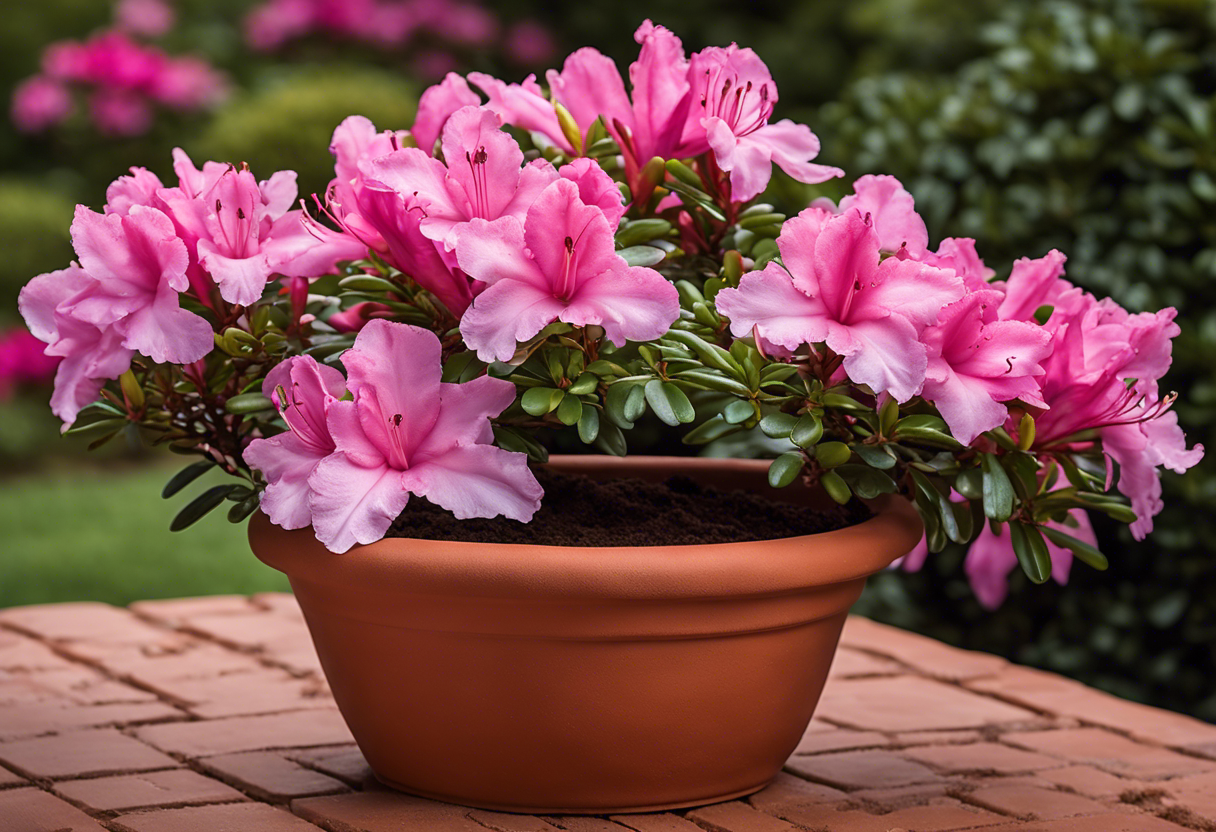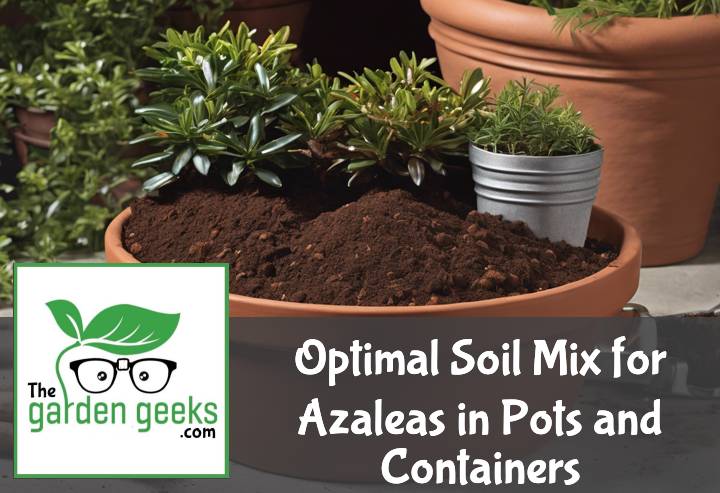Ever tried planting Optimal Soil Mix for Azaleas in pots and containers, only to have them wilt faster than a popsicle on a hot day? If so, I feel you. I’ve been there, done that, got the t-shirt (and the dead azaleas to prove it).
But fear not, my fellow green thumbs! There’s hope yet. Turns out, these finicky flowers need a specific soil mix to truly thrive. So buckle up and get ready to learn all about it! Keep reading about Optimal Soil Mix for Azaleas in Pots and Containers.
Key Takeaways
- Azaleas thrive in acidic soil with a pH of 4.5-6.0.
- A well-draining soil mix is crucial to prevent root rot; use a blend of 50% organic material (like peat moss or compost) and 50% coarse, gritty material (like perlite or sand).
- Regularly test the soil’s pH and adjust as necessary using sulfur to lower or limestone to raise it.
- Fertilize azaleas sparingly and only with a slow-release, low-nitrogen fertilizer.
- Mulching helps retain moisture and maintain acidity levels.

Understanding Azaleas: A Brief Overview
Azaleas, with their vibrant blooms and lush foliage, are a gardener’s delight. However, these beauties have unique characteristics that demand a special soil for azaleas. Let’s delve into the world of azalea plants and understand why they need a specific soil mix.
What are Azaleas?
Azaleas, my friend, are more than just pretty flowers. They’re part of the Rhododendron family and boast over 10,000 different types! Now that’s diversity for you! Their botanical features include evergreen or deciduous leaves and stunningly colorful flowers.
Identifying azaleas is like recognizing your favorite celebrity in a crowd – their vibrant colors and distinct shape make them stand out. So next time you see those beautiful blooms, you can proudly say “That’s an azalea!”
Why do Azaleas Need Special Soil Mix?
Now here comes the interesting part – why do these beauties need a special soil mix? Well, it all boils down to their root system. Unlike other plants, azaleas have shallow roots that prefer well-drained soil.
If they’re stuck in heavy clay or soggy soil, they’ll throw a tantrum by not growing properly. And trust me; you don’t want to see an azalea tantrum! It affects their health and growth significantly.
So remember folks, if you want your azalea to be the belle of the ball (or garden), give her what she wants – an optimal soil mix for azaleas!
The Importance of Soil for Azaleas in Pots and Containers

Soil is like the lifeblood of your Azaleas, especially when they’re snug in pots or containers. It’s not just about holding the plant upright; it’s a whole ecosystem that helps your Azalea thrive.
Role of Soil in Plant Health
Think of soil as a buffet table for plants. It’s packed with nutrients that plants gobble up to grow strong and healthy. But here’s the kicker – Azaleas are picky eaters! They need their soil to be just right, or they’ll throw a plant tantrum.
Specific Needs of Azaleas
Azaleas have some pretty specific demands when it comes to their soil environment. They love a good pH balance, need plenty of nutrients, and let’s not forget about drainage – no one likes soggy roots! And if you can add some organic matter into the mix, you’re on track for some bloomin’ good results with your Optimal Soil Mix for Azaleas.

Components of an Optimal Soil Mix for Azaleas
Creating the right Azalea soil mix is like baking a cake. You need the right ingredients in the right proportions. It’s all about organic matter, pH levels, and drainage properties. These are the key to optimal soil components for your azaleas.
Organic Matter: Why is it Important?
Organic matter is like the secret sauce in your azalea potting mix. It provides essential nutrients that azaleas crave. Think of it as a buffet for your plants, offering up a smorgasbord of goodies they can’t resist.
But it’s not just about feeding them. Organic matter also improves soil structure, making it easier for roots to spread out and get comfy. It’s like giving your azaleas a cozy bed to snuggle into.
So next time you’re preparing your soil mix for azaleas, don’t skimp on the compost!
pH Levels: What’s Ideal for Azaleas?
Now let’s talk about pH levels. Azaleas are picky eaters, preferring their meals served at a certain pH level. The ideal range? That would be slightly acidic – around 4.5 to 6.
Maintaining this pH level in your potting mix isn’t just about keeping your plants happy (though that’s important too!). It also helps ensure they can absorb all those tasty nutrients you’ve added with the organic matter.
So remember, when adjusting the soil pH for azaleas, think “slightly sour”. Your plants will thank you!
Drainage Properties: How to Achieve the Right Balance?
Finally, we come to drainage properties – another crucial ingredient in our azalea soil mix recipe. Too much water and your azaleas might drown; too little and they’ll dry out faster than a raisin in the sun.
The trick is to strike a balance. You want your soil to hold enough moisture to keep your azaleas hydrated, but not so much that it becomes waterlogged.
Adding coarse sand or perlite can help improve drainage, making it easier for excess water to escape. So if you’re into container gardening with azaleas, don’t forget this important step!
Creating the Perfect Soil Mix for Your Azalea
Creating an optimal soil mix for azaleas is a bit like baking a cake. You need the right ingredients in the right proportions. The base material, pH levels, and organic matter all play crucial roles in your azalea soil mix. It’s not just about having a green thumb, it’s about understanding what makes your azaleas tick.
Choosing the Right Base Material
Choosing the best base material for azaleas can feel like being on a game show. You’ve got to pick the right door! Azaleas prefer well-drained soil, so look for materials that don’t retain too much water.
A good choice is a mix of coarse pine bark and peat moss. This combo creates an ideal environment for your potted azaleas, providing both drainage and acidity.
Adjusting pH Levels for Azalea Health
Now let’s talk about pH levels. If you’re scratching your head thinking “pH whaaat?”, don’t worry! Basically, it’s all about acidity or alkalinity of your azalea potting mix.
Azaleas love slightly acidic soil with a pH between 4.5 and 6.0. So, if you’re not hitting those numbers, you’ll need to adjust by adding sulfur or limestone to increase or decrease acidity respectively.
Incorporating Organic Matter into Your Mix
Finally, let’s sprinkle some magic dust – organic matter! Adding organic matter into your azalea soil is like giving them a multivitamin.
Compost or well-rotted manure are great choices as they provide nutrients and improve soil structure. This will enhance growth and give your potted azaleas that extra oomph they need to flourish beautifully in their containers.
Keeping Up with Your Soil Mix: Maintenance is Key!
Maintaining the quality of your soil mix is crucial when it comes to Azalea pot care. It’s not just about getting the optimal soil mix for Azaleas right at the start, but also about keeping it in top condition over time.
Regular pH Testing and Adjustment
One way to ensure your soil stays optimal for Azaleas is through regular pH testing for plants. You see, Azaleas are a bit picky and prefer their soil on the acidic side. So, keeping an eye on the pH level of your soil mix can help you maintain those perfect conditions they love.
But what if your pH isn’t quite right? Well, that’s where adjusting soil pH comes into play. By adding certain substances like sulphur or lime, you can tweak that pH to meet your Azalea’s needs. Remember, maintaining plant health is all about creating a comfy home for them!
Replenishing Organic Matter Periodically
Another important aspect of soil mix maintenance involves replenishing organic matter in the mix periodically. This isn’t just some fancy gardening lingo – it’s essential for healthy growth of Azaleas.
Organic matter acts like a multivitamin for plants, providing them with essential nutrients they need to thrive. So adding some fresh compost or well-rotted manure can do wonders for your potted Azaleas.
Remember, container gardening isn’t just about looking pretty – it’s also about keeping those plants happy and healthy! And with these tips on board, you’re well on your way to becoming an expert in Azalea pot care!
Common Mistakes to Avoid When Preparing and Maintaining Soil Mix for Azaleas
When it comes to the optimal soil mix for azaleas, there are a few common mistakes that can turn your gardening efforts into a disaster. We’re talking about over-fertilizing and poor drainage – two big no-nos in the world of azalea care.
Over-fertilizing Your Soil Mix
Ever heard of too much love being a bad thing? Well, when it comes to fertilizing your azaleas, this saying rings true. Overdoing it with the nutrients can lead to some serious azalea fertilizer problems.
You see, excessive nutrients in the soil can cause harm from over-fertilizing. It’s like feeding your plants a super-sized fast food meal every day – not exactly the recipe for healthy growth, right?
So remember folks, maintaining a balanced soil mix nutrient balance is key. Don’t let your green thumb get carried away with the fertilizer bag!
Ignoring Signs of Poor Drainage
Now let’s talk about another common mistake: ignoring signs of poor drainage. If you notice waterlogged azalea roots or other symptoms of poor drainage, don’t just shrug it off.
These ignored drainage issues could be an SOS call from your plants! They’re basically saying “Hey, we’re drowning here!”
Good drainage is crucial for keeping those roots healthy and happy. So if you spot any signs of unhealthy soil conditions, take action pronto! Remember folks, when it comes to maintaining azalea soil, prevention is better than cure!

To Wrap Up
So, we’ve dug deep into the world of azaleas and their love for a perfect home, just like Goldilocks needed her porridge – not too hot, not too cold, but just right. The Optimal Soil Mix for Azaleas is your secret weapon to vibrant and healthy azaleas.
Remember folks, treat your azaleas like royalty; give them the right throne (pot) and the perfect feast (soil mix). Now go forth and conquer the gardening world with your blooming beauties!


